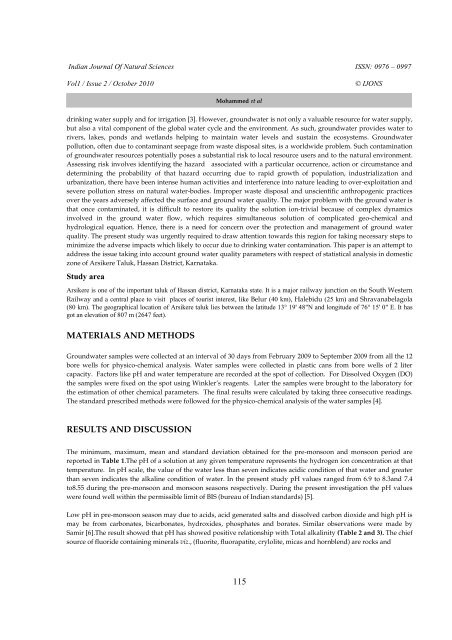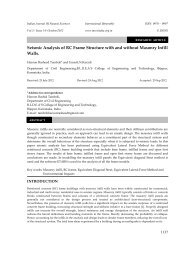Agroecology for Sustainable Food Security - tnsroindia.org.in
Agroecology for Sustainable Food Security - tnsroindia.org.in
Agroecology for Sustainable Food Security - tnsroindia.org.in
You also want an ePaper? Increase the reach of your titles
YUMPU automatically turns print PDFs into web optimized ePapers that Google loves.
Indian Journal Of Natural Sciences ISSN: 0976 – 0997<br />
Vol1 / Issue 2 / October 2010 © IJONS<br />
dr<strong>in</strong>k<strong>in</strong>g water supply and <strong>for</strong> irrigation [3]. However, groundwater is not only a valuable resource <strong>for</strong> water supply,<br />
but also a vital component of the global water cycle and the environment. As such, groundwater provides water to<br />
rivers, lakes, ponds and wetlands help<strong>in</strong>g to ma<strong>in</strong>ta<strong>in</strong> water levels and susta<strong>in</strong> the ecosystems. Groundwater<br />
pollution, often due to contam<strong>in</strong>ant seepage from waste disposal sites, is a worldwide problem. Such contam<strong>in</strong>ation<br />
of groundwater resources potentially poses a substantial risk to local resource users and to the natural environment.<br />
Assess<strong>in</strong>g risk <strong>in</strong>volves identify<strong>in</strong>g the hazard associated with a particular occurrence, action or circumstance and<br />
determ<strong>in</strong><strong>in</strong>g the probability of that hazard occurr<strong>in</strong>g due to rapid growth of population, <strong>in</strong>dustrialization and<br />
urbanization, there have been <strong>in</strong>tense human activities and <strong>in</strong>terference <strong>in</strong>to nature lead<strong>in</strong>g to over-exploitation and<br />
severe pollution stress on natural water-bodies. Improper waste disposal and unscientific anthropogenic practices<br />
over the years adversely affected the surface and ground water quality. The major problem with the ground water is<br />
that once contam<strong>in</strong>ated, it is difficult to restore its quality the solution ion-trivial because of complex dynamics<br />
<strong>in</strong>volved <strong>in</strong> the ground water flow, which requires simultaneous solution of complicated geo-chemical and<br />
hydrological equation. Hence, there is a need <strong>for</strong> concern over the protection and management of ground water<br />
quality. The present study was urgently required to draw attention towards this region <strong>for</strong> tak<strong>in</strong>g necessary steps to<br />
m<strong>in</strong>imize the adverse impacts which likely to occur due to dr<strong>in</strong>k<strong>in</strong>g water contam<strong>in</strong>ation. This paper is an attempt to<br />
address the issue tak<strong>in</strong>g <strong>in</strong>to account ground water quality parameters with respect of statistical analysis <strong>in</strong> domestic<br />
zone of Arsikere Taluk, Hassan District, Karnataka.<br />
Study area<br />
Arsikere is one of the important taluk of Hassan district, Karnataka state. It is a major railway junction on the South Western<br />
Railway and a central place to visit places of tourist <strong>in</strong>terest, like Belur (40 km), Halebidu (25 km) and Shravanabelagola<br />
(80 km). The geographical location of Arsikere taluk lies between the latitude 13° 19' 48"N and longitude of 76° 15' 0" E. It has<br />
got an elevation of 807 m (2647 feet).<br />
MATERIALS AND METHODS<br />
Groundwater samples were collected at an <strong>in</strong>terval of 30 days from February 2009 to September 2009 from all the 12<br />
bore wells <strong>for</strong> physico-chemical analysis. Water samples were collected <strong>in</strong> plastic cans from bore wells of 2 liter<br />
capacity. Factors like pH and water temperature are recorded at the spot of collection. For Dissolved Oxygen (DO)<br />
the samples were fixed on the spot us<strong>in</strong>g W<strong>in</strong>kler’s reagents. Later the samples were brought to the laboratory <strong>for</strong><br />
the estimation of other chemical parameters. The f<strong>in</strong>al results were calculated by tak<strong>in</strong>g three consecutive read<strong>in</strong>gs.<br />
The standard prescribed methods were followed <strong>for</strong> the physico-chemical analysis of the water samples [4].<br />
RESULTS AND DISCUSSION<br />
Mohammed et al<br />
The m<strong>in</strong>imum, maximum, mean and standard deviation obta<strong>in</strong>ed <strong>for</strong> the pre-monsoon and monsoon period are<br />
reported <strong>in</strong> Table 1.The pH of a solution at any given temperature represents the hydrogen ion concentration at that<br />
temperature. In pH scale, the value of the water less than seven <strong>in</strong>dicates acidic condition of that water and greater<br />
than seven <strong>in</strong>dicates the alkal<strong>in</strong>e condition of water. In the present study pH values ranged from 6.9 to 8.3and 7.4<br />
to8.55 dur<strong>in</strong>g the pre-monsoon and monsoon seasons respectively. Dur<strong>in</strong>g the present <strong>in</strong>vestigation the pH values<br />
were found well with<strong>in</strong> the permissible limit of BIS (bureau of Indian standards) [5].<br />
Low pH <strong>in</strong> pre-monsoon season may due to acids, acid generated salts and dissolved carbon dioxide and high pH is<br />
may be from carbonates, bicarbonates, hydroxides, phosphates and borates. Similar observations were made by<br />
Samir [6].The result showed that pH has showed positive relationship with Total alkal<strong>in</strong>ity (Table 2 and 3). The chief<br />
source of fluoride conta<strong>in</strong><strong>in</strong>g m<strong>in</strong>erals viz., (fluorite, fluorapatite, crylolite, micas and hornblend) are rocks and<br />
115



